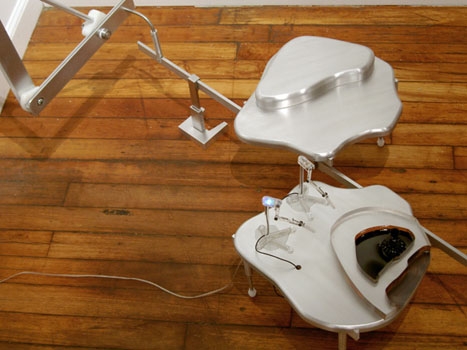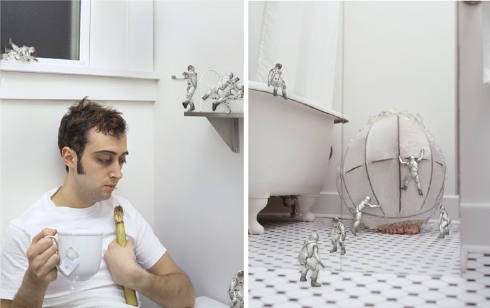SABRINA RAAF
At times I have described my work as falling under the categories of wearable sound, interactive electronic installation, and digital imaging. At other times I have grouped it in with the disciplines of video telepresence, animation, performance, and robotics. Like many artists working amongst and between these categories, the final materials that are used in my production tend to be of less importance than the continuity of the artistic research and ideas behind them. I am driven by a fascination with the design and construction of systems that are organic-electronic hybrids and that have a true function that goes beyond their existence as cultural objects. I am interested in making creative machines - machines that independently make art when cross-pollinated with human interaction. These artworks’ behaviors are based in generative algorithms embedded within them. I use networks, reflexivity, and the interplay of randomness and pattern to initiate a genuine engagement of the machines with human visitors and vice versa. I view such innovations as tools for creating new experiential frameworks that question the nature of creativity and authorship.
In 1999 I began experimenting with ideas of how common elements of household and commercial building interiors could be repurposed into informative and metaphoric interfaces. My first artwork along this line of inquiry was the Unstoppable Hum (1999). This was a large sculptural artwork that monitored various electromechanical activities in a building such as automatic doors, security, ventilation, computer and phone systems. It tracked their patterns of activity and then created musical compositions on the fly that expressed the complexity of that activity. Humans thereby were informed of when and how much the structure around them was working towards maintaining the safety and comfort of their habitat. In 2002 I created Dry Translator which included two custom designed audio vests and an interactive wall. When a gallery visitor touched the drywall of the gallery, they heard the sound of their touch not locally where their fingers hit the wall, but actually on their own torso as the sound was amplified and transmitted wirelessly to the audio vest they were wearing. The walls thereby became skin-like extensions of the participant’s own body. Participants were also able to record a series of touches or gestures on the drywall via an interactive consol and, in doing so, leave a “touch message” for the next participant to play back on the vest.
My most recent research continues to focus on architectural interfaces but now via telepresence and with an aesthetic of weightlessness. I am producing a new series of video-enabled rovers (robotic vehicles) - some of which may be operated over the Internet. This current work is inspired in part by the exploratory rovers sent to Mars as well as the concurrent proliferation of personal webcams. Webcams have become a phenomenally pervasive tool for exploring remote public and domestic landscapes. The first work completed in this series is searchstoretrash (2003). For this piece, I custom fabricated a track of thin translucent material that extends up, down, and through a gallery space. Visitors are able to navigate the track via a remote controlled rover with a live video feed. They thereby “experience” the gallery space from either a mouse’s or a fly’s eye point of view depending on the rover’s location. This is an opportunity for people to explore the gallery environment from odd and unusual vantage points and perhaps - through this process - gain some perspective -both literally and figuratively - on that environment.
Artists of influence to my work are David Rokeby, George Gessart, Joe Davis, Sarah Sze, Charlie White, Inigo Manglano-Ovalle, R. Buckminster Fuller, and Louis Bec.



